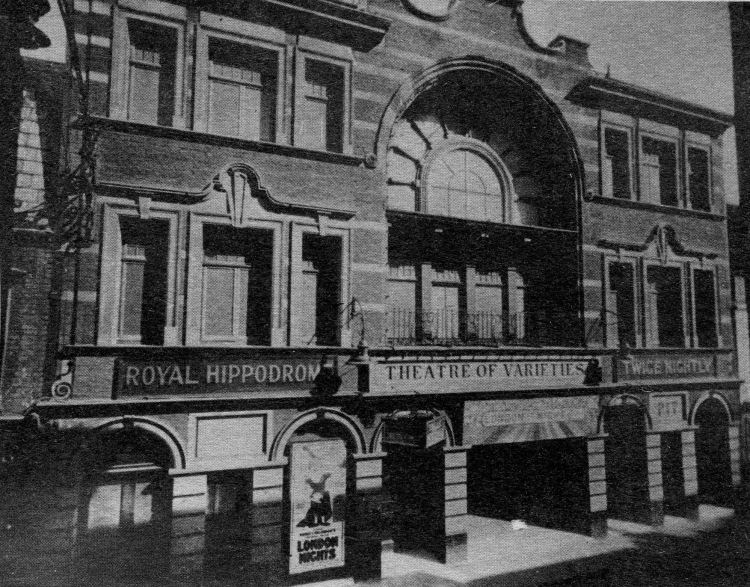Page Updated:- Sunday, 07 March, 2021. |
|||||
 Published in the Dover Express, 15 February, 1980. A PERAMBULATION OF THE TOWN, PORT AND FORTRESS. PART 59.
THE VOID UNDERCLIFF When James 1 granted his charter to the Dover Harbour Commissioners, the particulars given in that document indicate that, between Snar Gate and the buildings in the Pier district, there was a wide gap; indeed, we may assume that, in 1606, the whole of the lower part of Snargate Street was void. There is one fact connected with the early history of the lower part of Snargate Street which is curious — that is that, at two isolated points, blocks of property on the seaward side of the street were in what was St James’s parish. The one block not far below the site of the gate, namely, Nos 20 and 21, including the Wellington Hall, with the corresponding property at its back, in Northampton Street; and the other block consisted of four houses, pulled down in 1930, opposite the Grand Shaft, with the corresponding houses at the back of them, in Commercial Quay. The whole of the land below Snar Gate, when left dry by the recession of the sea, was extra-parochial, until buildings were erected, and then efforts were made by adjoining parishes to claim it for the sake of the revenue. In ancient times, St James’s was regarded as the fishermen’s church, being chiefly for the benefit of the fishing community, who beached their boats and dried their nets on the shore that, in Medieval times, sloped up to that church door. When, an the reign of Henry VII, the destruction of the eastern harbour partially transferred the fishing community to the western side of the town, it is very probable that fishermen of St James’s congregation had landing places, and probably some buildings, at the two points above named; and so those places came to be treated as a part of St James’s parish before Snargate Street was continued down to those points. About the year 1634, when large portions of land had been reclaimed within the Pier district, and the rateable value become large, the Vicar of Hougham claimed it, by filing a Bill in the Court of Chancery; but the parish of St Mary made a counterclaim, and, in consequence, the whole of the lower part of Snargate Street, as well as the other part of the Pier, was added to St Mary's parish, excepting these detached parts of St James’s.
BELOW SNAR GATE Immediately below the "Gate" in Snargate Street, No 17, formerly the office of the Dover Standard, had been the residence of Sir Luke Smithett, and, earlier, of Sir John Hamilton, Sir Luke’s father-in-law, the latter taking up his residence there in June, 1845, when the London and County Bank vacated those premises to occupy others lower down, now the Masonic Hall. The strong vaults of the Bank were left in the basement of the premises. Sir John Hamilton was one of our sea warriors of the 18th Century. He commanded the Active on 11th October, 1797, when Admiral Duncan, with sixteen sail of the line, attacked and captured the Dutch Fleet, under Admiral de Winter, off Camperdown. For that victory Duncan was elevated to the peerage, and Hamilton was knighted. Sir Luke Smithett also won his honours on the sea, but more peacefully. He was born in the year 1800, and, at the age of 25, took command of one of H.M. Packets on the Irish Station, and, later on, the Mail Service between Dover and Calais, which he continued to be associated with until 1854. He was generally selected to accompany the Royal yacht, and to conduct Royal Visitors to and from this country. He was in command of the vessel which brought the Prince Consort to this country in 1840; and although he had ceased to be regularly employed on the passage, he commanded the vessel which brought over the Emperor and Empress of the French in 1855, and he was engaged at Calais, in 1854, at the embarkation of the French Fleet for the Baltic. He married Jane, the youngest daughter of Sir John Hamilton. Sir Luke, after his retirement, settled in Dover, was made a Justice of the Peace, Deputy Lieutenant for the County of Kent, and was knighted in 1862. He finished his course on the 17th December, 1871, and his interment in Cowgate Hill Cemetery was the occasion of a public funeral.

Apart from the way the character of the old town of Dover was changed by the devastation wrought by bombing and shelling during the last war, one of the most lamented losses was that of the old "Royal Hippodrome" theatre. This popular entertainment spot — the spacious building extended from Snargate Street through to Northampton Street — was so badly damaged by enemy action that it had to be demolished after the war.
|
|||||
|
If anyone should have any a better picture than any on this page, or think I should add one they have, please email me at the following address:-
|
|||||
| LAST PAGE |
|
MENU PAGE |
|
NEXT PAGE | |